Locomotive Engineer Darrin Crone provides us with an insight into recent weeks’ work.
Week commencing 2 August
Our first working Monday of a 6 day working week went well. The Engineering Team made good progress with our main job of the moment, the stripping of the frames to bare metal for thorough examination. Needle gunning of the frames has continued non-stop this week and we have now progressed as far forward as the centre coupled wheels.

Also this week the de-carboning and cleaning of the pistons has been completed and the 2:1 lever has been stripped of paint and cleaned. The packing of the crank pins of the coupled wheels has now been completed. On the subject of the wheels the haulier for the move to our re-tyring contractor was sorted this week and the wheelsets are to be moved next week.
De-carboning the steam chests has been started. Our CME has briefly inspected the steam chest and said he was very pleased with the results. Our CME was on site to measure the middle slidebars before removal.
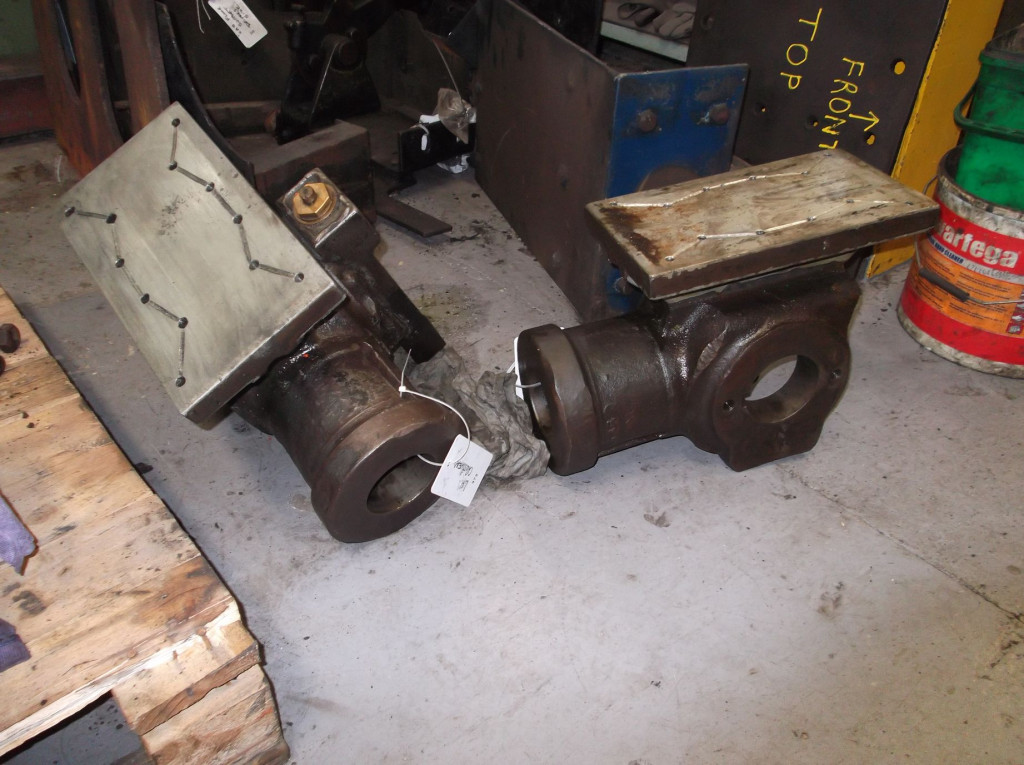
The invitations to quote for the boiler were sent out at the end of last week. We have had a couple of works saying they are not available to do the work due to their own workloads but we have had other promising responses.
The outside ones have been measured and were removed last week. While on site the driving wheelset crank pins and journals were inspected and measured. This wheelset can now be prepared for transporting to our re-tyring contractors.
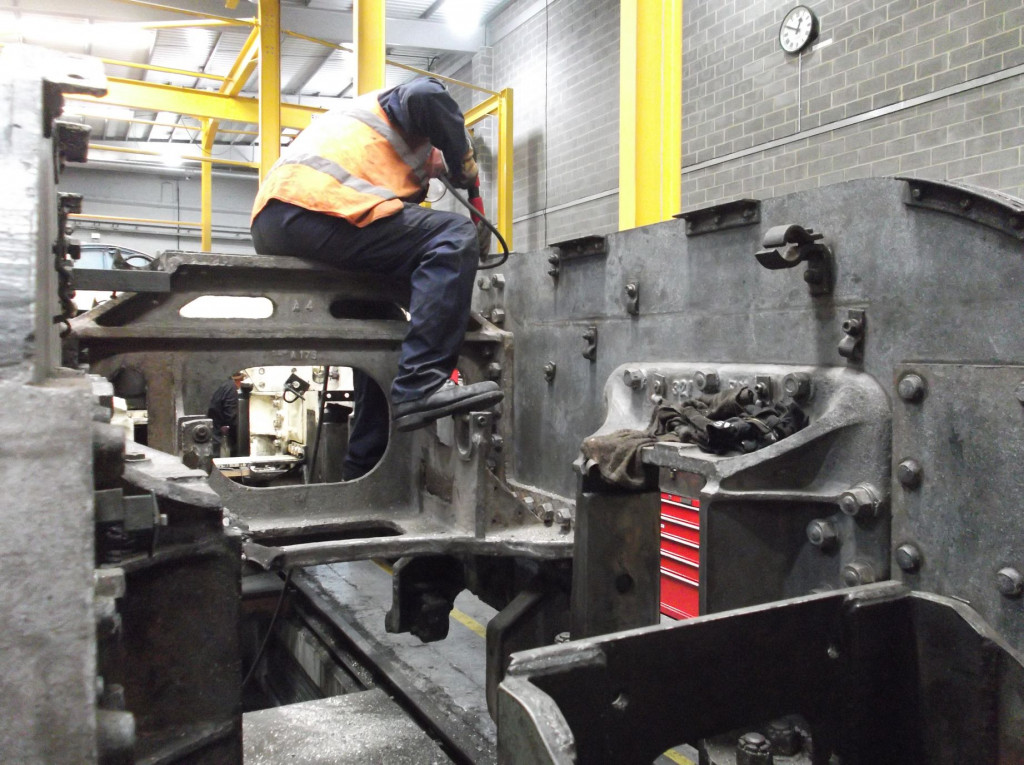
Back on the frames the 2 sand boxes that feed the centre/driving coupled wheels were removed this week, with their associated filling pipes. With the availability of the overhead crane they were easily removed and left at the front of the loco for cleaning. The inside of the frames where the boxes were appears to be in very good condition though interestingly while being cleaned it looks like there are traces of red paint. So what should be the correct colour between the frames, white or red?
Also this week the middle crosshead and slidebars were removed. They were measured last Saturday and this allowed us to remove them this week. With needle gunning and the removal of the sandboxes going on between the frames the job of removing the slidebars was set up on Tuesday but had to wait until Thursday before we could complete the removal.
Week commencing 9 August
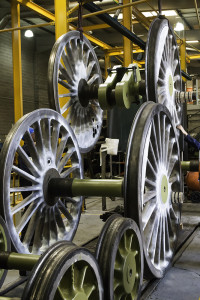
The frame stripping marathon end seems to be in sight. The frames are now stripped to the cylinder block, with some work left around the dragbox area. Not only has there been paint to remove but some areas of corrosion, so the needle gun and wire brushes have had continuous use.
Again this week everybody has had a go and the Engineering Team volunteers should be thanked for their perseverance. Inside the frames below and in front of the cylinders still need to be stripped but cleaning in this area is well under way.
Again on the frames the middle steam chest has now been thoroughly cleaned. All have now been treated so they can now all be inspected. However we will have to return to the accessible parts of the steam passages in the future to remove as much carbon as possible.
The wheelsets were transported to our re-tyring contractor this week. Priming the bogie wheelsets was completed on Monday in preparation. On Tuesday, the day before the wheelsets were due to be loaded, we had to get the crank axle wheelset in position ready to be lifted.
This wheelset has been in front of the loco but preventing it from going under the overhead crane was the GUV. So we pinched the GUV forward as far as we could. Unfortunately we still couldn’t get the wheelset far enough forward to get a lift off the crane, but the wheels were on the wheeldrop, so we lowered the wheels in to the pit. In the pit the wheels could then be moved to get a straight lift off the crane.
Next day the haulier arrived and left his trailer in the west car park and brought his rigid chassis truck round to the workshop. The rigid allowed the truck to be reversed under the workshop crane. The first wheelset, the cranked, was lifted from the wheeldrop pit and put on the lorry. The haulier had gone to a lot of trouble in preparing an impressive jig to safely support and secure the wheelsets.
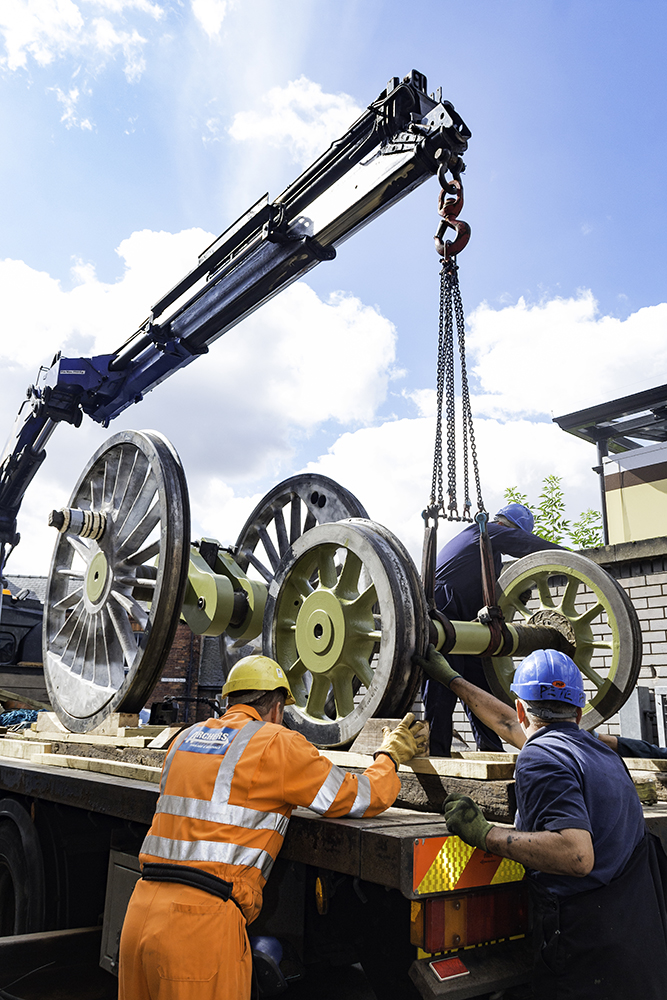
After this first wheelset was loaded the crane button was pressed to traverse the crane back into the workshop but it refused to go. It was realised that the power supply cable had snagged and had pulled from the crane.
Charlie Bird of the NRM immediately swung in to action to repair it while the Engineering Team manhandled a bogie wheelset out of the workshop and in to the yard where the truck’s hi-ab crane was used to load it. Both loaded wheelsets were then taken to the trailer in the west car park and loaded on to the trailer.
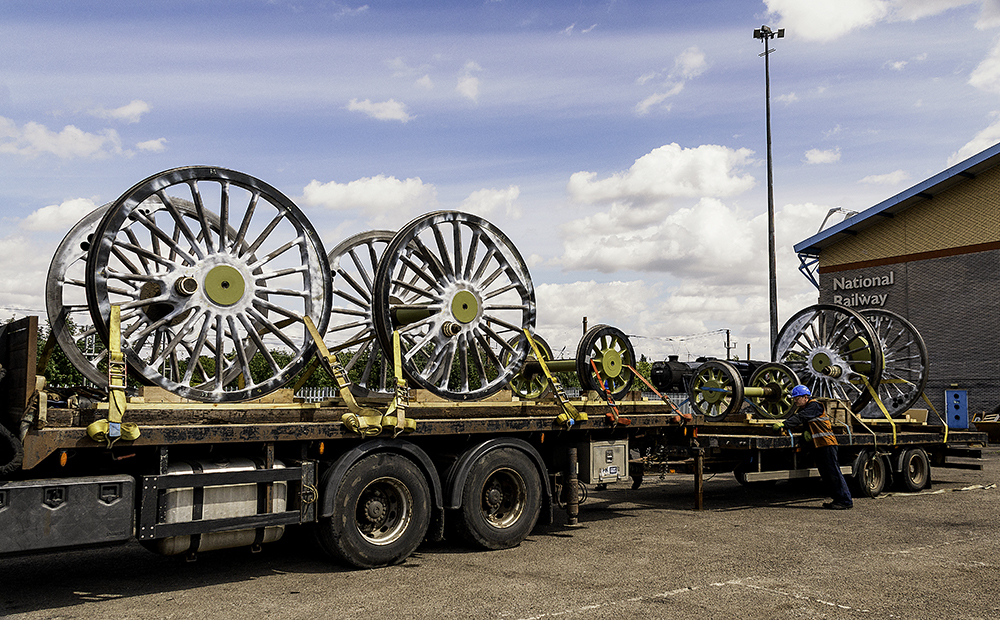
By the time we had trans-shipped the wheels and returned to the workshop Charlie had fixed the crane and loading the remaining wheelsets was straight forward. Finally the full consist was assembled in the west car park and the wheels disappeared down Leeman Road. They were unloaded at Buckfastliegh the following morning.
It was a magnificent effort from the Engineering Team volunteers as there was a lot to do to load and help secure the wheels on the truck. The co-operation from the National Railway Museum was outstanding. In the workshop Charlie was fantastic, not only fixing the crane but co-ordinating with other NRM departments to get us access and space in the west car park and organising the use of the workshop crane through the workshop viewing gallery when the NRM was open to the public.
Week commencing 16 August
Everyone on the Engineering team has put a lot of effort into carrying out another week of needle gunning the frames. We have completed to the back of the frames, with just some isolated areas and the drag box casting to complete. The drag box looks to be good condition.
Up front, the space in front of the middle cylinder has been cleaned so that needle gunning can start in here. By Friday a good part of the front of the middle cylinder casting and some of the underneath of the saddle casting had received the attention of the needle gun. The frames have been needle gunned to the front along the bottom and a good start has been made to the box section stretcher that the 2:1 gear swings in.
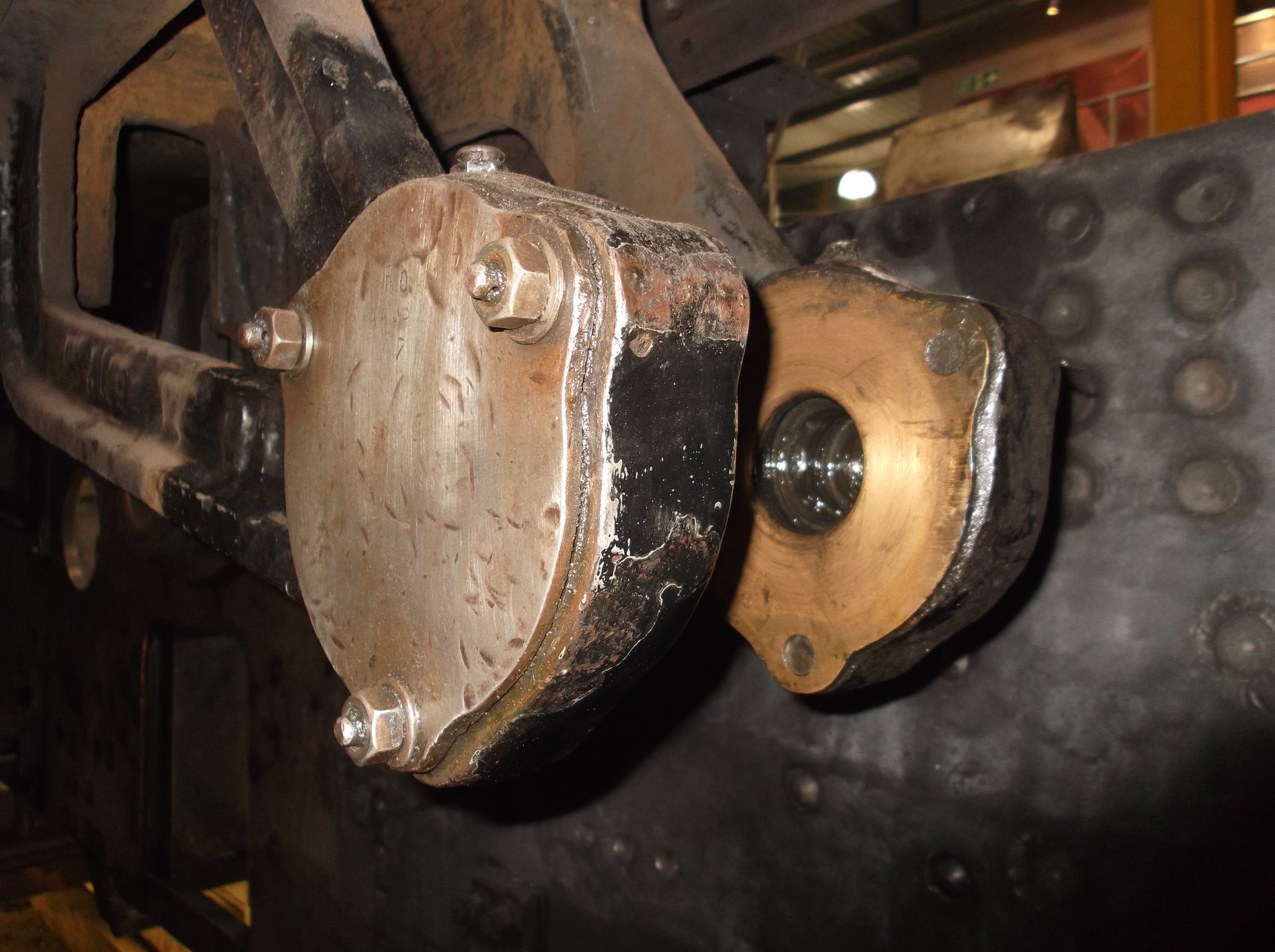
Elsewhere on the frames the expansion link trunnion bearings were removed. With these removed the expansion link brackets can be cleaned and after the frame plates and stretchers are stripped the external brackets can be similarly treated.
On Tuesday the bogie frames were moved from immediately behind the tender to underneath the wheel drop crane. This gives us more space to work on the bogie frames, released by the wheelsets that have now been sent to the re-tyring contractors. Once some final cleaning is done to the top of the frames they will be turned over and cleaned.
The superheater header bottom was thickness tested this week. After this was completed the header was turned over and the top was thoroughly cleaned off. It is now ready for this side to be inspected.

A start has been made this week on cleaning the coupled wheel axleboxes in preparation for inspection and eventual re-metalling. The first to be done is RL (right leading), that was originally marked 26 RB. On Thursday work continued in cleaning the piston valves. Work on the valves started a couple of weeks ago but now some trestles have been set up and cleaning of the ring grooves started.
In the boiler the leading longitudinal stays have been replaced. These had been removed to enable them and the areas in the boiler where they are fixed to be inspected. They have been stored under the support coach, which is some way from where the boiler has now been shunted, so the first job was to carry them to the far end of the yard. From there they were passed up through the front tubeplate, after which they had to be held up at the inside top of the boiler barrel while a securing pin was inserted to hold them up.
It was a tiring job with plenty of lifting, so it was a really good effort by the Engineering Team. With the stays in place, prospective boiler overhaulers can now check the fit and get an idea if there is any additional work to be done on them.
Week commencing 23 August
During our ‘works shutdown’, a number of the dedicated Engineering Team members went in to keep progress going. May that be an example to you all. The work area all around the locomotive was cleaned, leaving the NRM workshop as clean as when we first arrived. Meanwhile, work continued on the cleaning of the bogie frames by a couple of our dedicated volunteers.
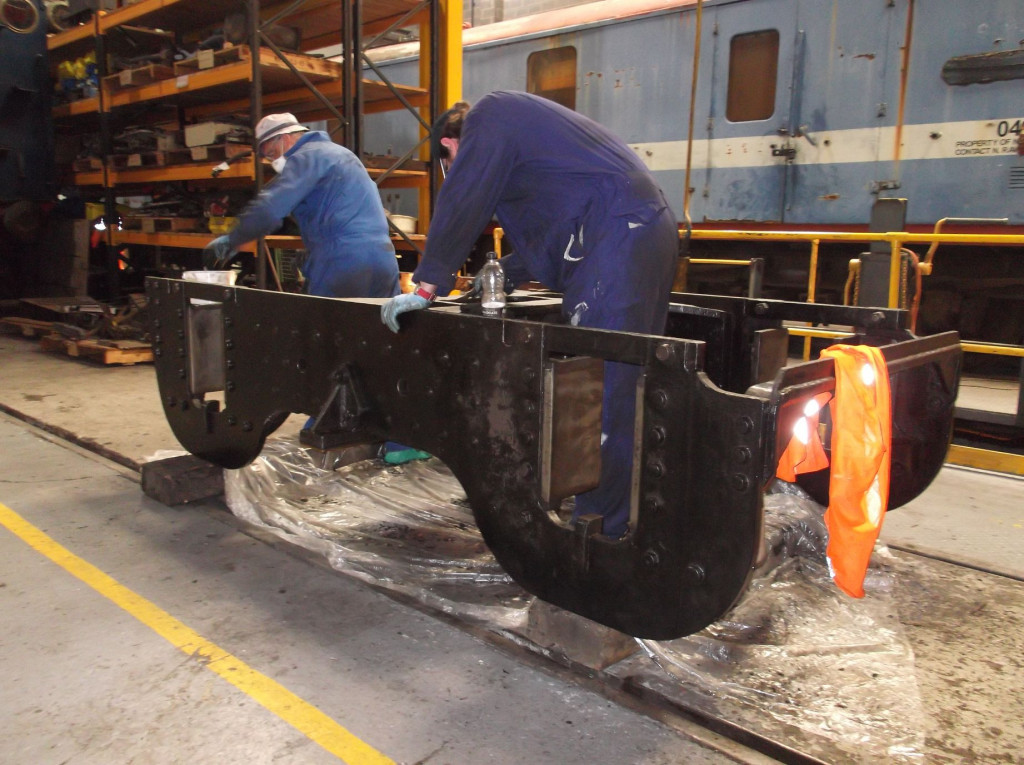
Last week work continued on the bogie frames. One of the NRM’s straight edges was used to inspect for wear the bearing surfaces on which the bogie centre block sits. After this inspection was completed the frames were turned over so that cleaning of the underside could be completed. This was done on Wednesday, and we must thank Charlie Bird of the NRM Workshop for letting us have use of the crane, which had been otherwise engaged for work on NRM’s Rocket reproduction. Cleaning started on the underside immediately after the frames were turned over. We soon found marking on the main centre casting ‘5/3/35’.
In addition to the inspection of the bogie bearing surfaces and the cleaning of the bogie frames, the removed centre block was cleaned. The block was turned over and the bearing surfaces were cleaned, ready for detailed inspection.
The crossheads were also cleaned this week. The oil reservoir caps were removed and reservoirs also cleaned out. Elsewhere, work continued on cleaning the coupled wheel axleboxes. This will enable them to be inspected in detail and, eventually, their remetalling.
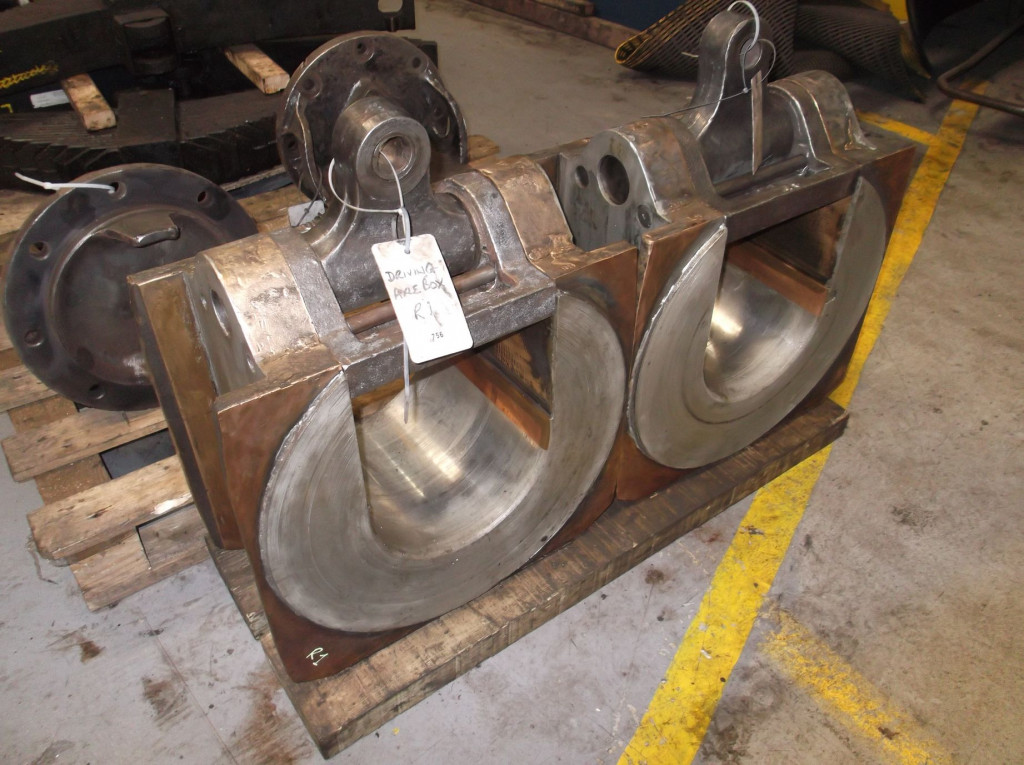
Also continuing this week is the cleaning out of the valve head ring grooves. It is essential that the grooves are clean so that the valve rings can be compressed to the bottom of the groove and can spring back out to give a good seal in the steam chest. The grooves get filled with very hard baked-on carbon deposits, which require meticulous scraping off.
On the mainframes, the right hand leading brake shaft bearing was removed. The other three bearings were removed some time ago but this one was stuck fast. Not even a hydraulic jack could budge it. It looked as it had moved in its housing, and this perhaps had increased the amount of force required to eventually move it. We didn’t want to damage the casting in which the bearing sits by applying too much force from the jack, so it was decided to cut the bearing out.
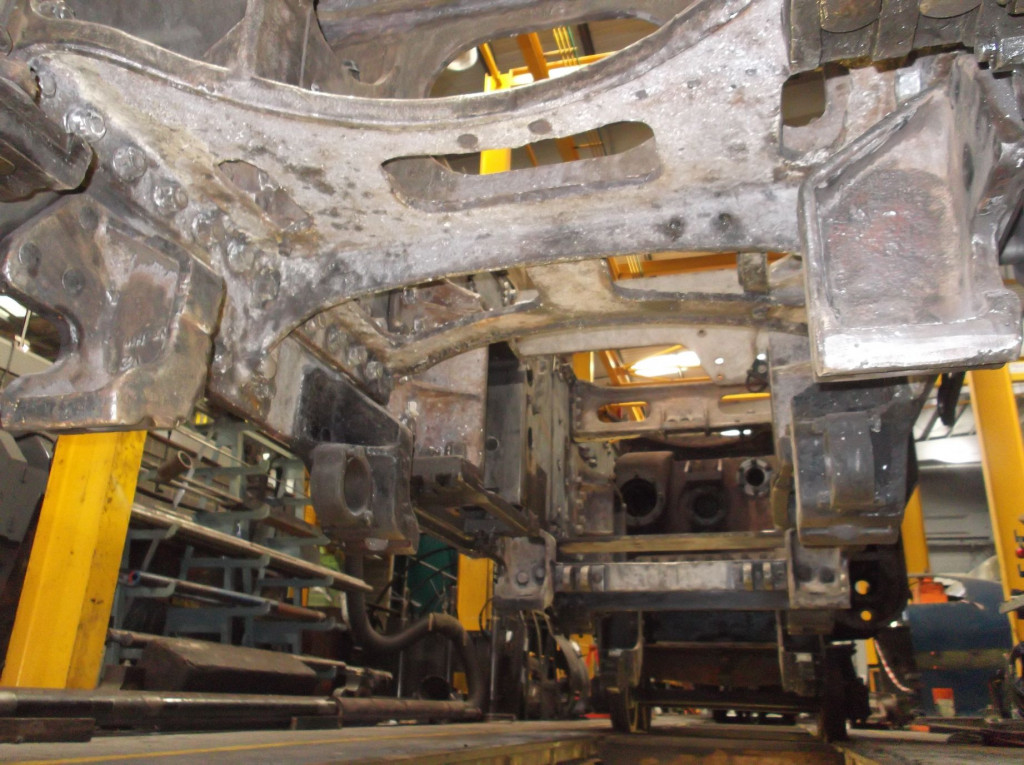
The needle gunning of the frame plates has been completed and this has enabled inspection of the frames to begin. By the end of the week the left hand outside of the frames, from the back end to behind the cylinders, has been completed. The frames are now covered in cryptic markings. I wonder what Facebook will make of it?
Though the frame plate needle gunning is complete the gun is still in daily use, this week on the inside cylinder casting front and the underneath of the saddle casting.
This is the sixth update – you can catch up on the previous posts here.
Good to see such thorough work going on to this A4 . So sad that only one A3 is now preserved. I learnt the other day that Flying Scotsman is coupled to the corridor tender once coupled to A4 Lord Faringdon No. 60034. I had a footplate ride on this locomotive in August 1959 (hauling the down Norseman) and spent much of the trip from King’s X to York and back standing on the front of this tender. (And through the corridor to the ‘cushions’ beyond). I was lucky enough to be allowed this footplate ride on the strength of my name..! I understand Sir Nigel to have been my distant uncle..!